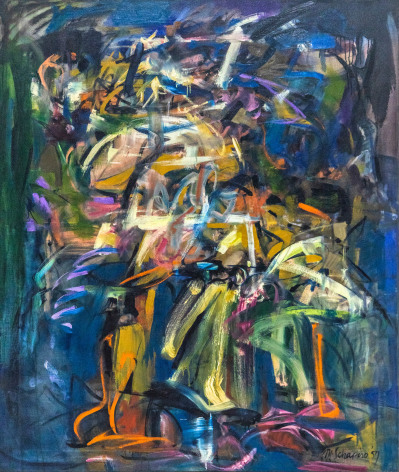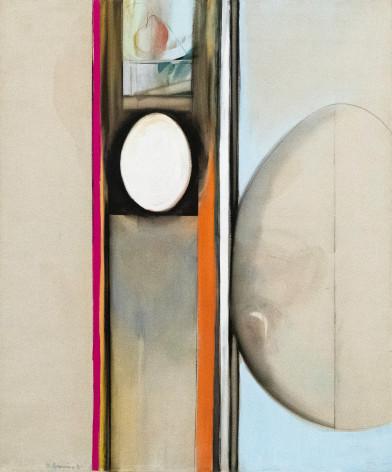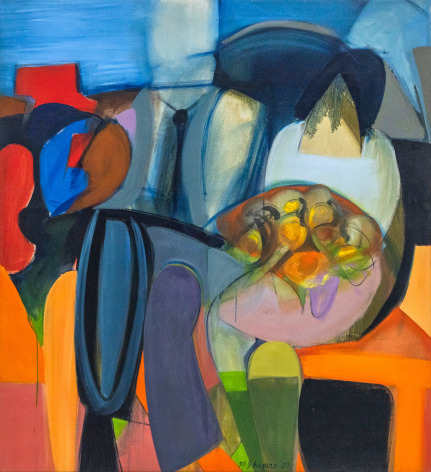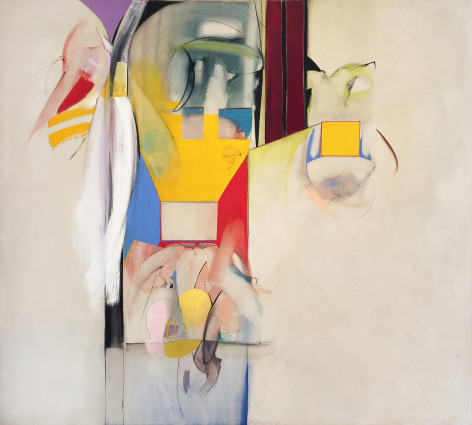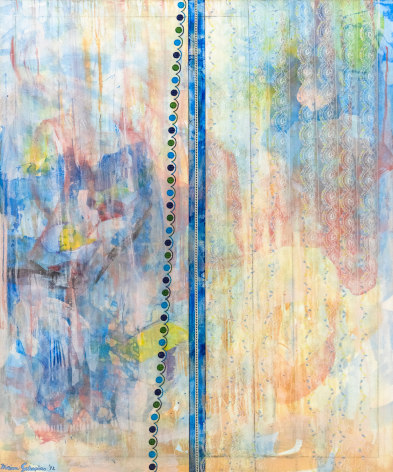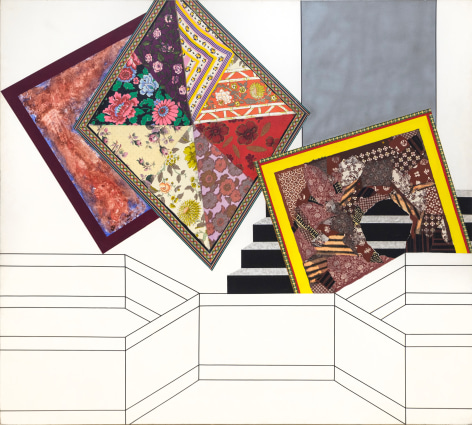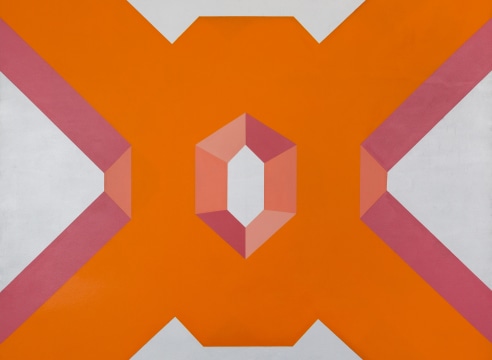
Eric Firestone Gallery’s presentation at Frieze Masters is a solo installation of work by pioneer feminist artist Miriam Schapiro (1923–2015). The presentation will span the 1950s through the 1970s, showing work in both her early Abstract Expressionist style as well as monumental “femmage” work, where she fused anonymous craftwork made by women with modernist, geometric painting.
In 1958, Schapiro was the first female artist to have a solo show at André Emmerich Gallery. Her Abstract Expressionist canvases of the 1950s are gestural and painterly yet also rooted in personal experience and her fascination with a vast range of visual culture, ranging from modernist masterpieces to tabloid photography. Even when invested in formal experimentation, Schapiro always imbued her canvases with content that had meaning to her. Typifying this idiom is Doll’s House (1959), a joyous abstraction in which loose figuration and the relationship between various forms suggest a domestic scene, reinforced by the appearance of gables, setting the tableau in an imagined home. The title hints at Schapiro’s varied interests—in essence, a dollhouse is a miniaturized fantasy of the home, much the same as Schapiro’s painted scene. The dollhouse, though, is also an element of women’s culture. Furthermore, the title alludes to Henrik Ibsen’s 1897 A Doll’s House, long embraced as a feminist play depicting a woman’s assertion of her own agency in abandoning her unfulfilling home life. Shifting attitudes about gender likely informed not only Schapiro’s invocation of the title but a broader appetite for the play, which NBC turned into a TV movie the same year as Schapiro created this painting.
By 1961, Schapiro explored a composition that represented her feeling of bursting from the confines of her prescribed roles of wife or mother. Her paintings began to take on an architectural logic, dominated by an imposing vertical band through the center of the canvas. In tension with her rigid lines, Schapiro incorporated shapes and symbols that were associated with the feminine. They included biomorphic forms, eggs, and apertures or windows, which the artist would explore throughout her career as “central core” imagery, associated with aspects of the libidinal and maternal body. Cloaked in the formal play of illusionism, Schapiro explored the two great poles of her practice: feminism and formalism. Of one significant example included in this installation, titled The Game (1960), Schapiro wrote:
"The Game is the game of making a real world on canvas. The Game is also the game of knowing that the made world can never be wholly real. The Game was the first painting to use the box as a symbol. The box became a house. I could no longer live in the jungle. I built the house out of all things I was unsure of and certain about. I called it a 'Shrine.'"
The shrine would become an important symbol for Schapiro in the early 1960s. Along with The Game, this installation includes two other works—Reprieve and Dialogue—that use the structure of the shrine, a painted space where Schapiro could exalt both the artistic and the feminine aspects of her identity. These “pre-Shrine” works immediately precede her illusionistically rendered, metaphysical “Shrine” paintings of the 1960s. Focusing on the earlier set within this display, the presentation foregrounds Schapiro’s interest in gesture and abstraction as anchors in this installation.
Throughout her career, Schapiro experimented with increasingly explicit references to women’s experiences. In 1971, Schapiro and Judy Chicago founded the Feminist Art Program at the California Institute of the Arts and conceived the legendary “Womanhouse'' installation. Having taken a break from her own studio practice during her involvement with the program, Schapiro’s work took a radical turn when she returned to painting in 1972. Curtains (1972) was Schapiro's first painting that incorporated fabric. The painting is made up of pink and blue washes with a sheer fabric covering the paint, with two lines running down the middle mimicking a zipper. Schapiro said of the work: “When I got back and looked at that picture I was absolutely horrified, horrified. I couldn't believe that I could make anything so corny. You'll have to take my word for that. And it frightened me." Schapiro remained committed to this new style of work that she termed “femmage,” to describe her process of collaging craft elements (traditionally gendered as female) into the “high art” of painting (historically the purview of male artists).
Additional highlights of the installation include Interview (1959), which demonstrates Schapiro’s use of press photography as source images for paintings. In this work, Schapiro was inspired by an image of the actress Gloria Swanson, along with Charles Lindbergh and his wife Anne Morrow Lindbergh. In the original photograph, the independence and extroverted pose of the actress is juxtaposed with the somber and contained personality of Mrs. Lindbergh, in her role as wife. Through shape and color, the gendered dynamics of the scene become externalized and reimagined. Shapiro creates a lively rhythm of colors—a steady parade of columnar forms abstracted from their legs: crossed and wound around the chairs. These are balanced by the more lyrical, gestural shapes of the circular basket on the lap of Mrs. Lindbergh.
In Lady Gengi's Maze (1972), Schapiro juxtaposes decorative craftwork with the illusionistic geometry she began to explore upon her move to California. With the title she references a long history of women’s contributions to the arts, alluding to The Tale of Genji, an 11th-century text by Japanese noblewoman Murasaki Shikibu, widely considered to be the first novel. In her reimagining, Schapiro depicts three "flying carpets" hovering over a reductive suggestion of an architectural setting. It is a dramatic combination of austere black and white linear elements with complex color, pattern, and decoration. The carpet at the right has an opening at the center, which demonstrates Schapiro’s continuing interest in the aperture or opening into another space. Intricate patterning, associations with domesticity, and anonymous craftsmanship made carpets a favorite motif for Schapiro throughout the 1970’s. Flying Carpet (1972), an early example of this exploration, collides several of Schapiro’s motifs noted elsewhere: the “central core” concept of Schapiro’s oeuvre, hard-edge abstraction, exuberant decoration, and literary allusion.
Schapiro has been the subject of numerous exhibitions and her work is held in collections worldwide, including the Metropolitan Museum of Art, the Whitney Museum of American Art, the Museum of Modern Art, New York, the Museum of Fine Arts, Boston, and the Peter and Irene Ludwig Collection, Germany. In 2018, the Museum of Arts and Design in New York presented Surface/Depth: The Decorative after Miriam Schapiro, presenting Schapiro’s femmage work alongside the work of contemporary artists.


